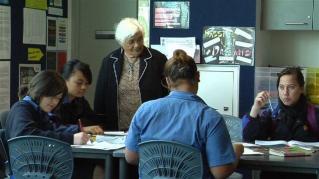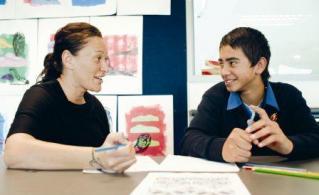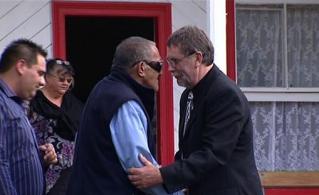Transcript
Narration
The opportunity to engage in professional conversations around teaching and learning raises the awareness of teachers’ thinking practice and their influence. Having collated student data and examined the research evidence, Greymouth High School sought further expertise to support them in improving the teaching and learning of Māori students.
Una Byrne – Teacher Greymouth High School
Our initial professional development was very general. It was about learning about culture, how do you use language in the classroom, putting up posters, using stickers, bilingual stickers and things like that. And a lot of teachers very quickly took that on board. But very quickly we found we were saying: “That isn't enough”. We want to know how the kids learn. And we want to help them to learn.
Una Byrne
We'd had a lot of professional development about feedback and feed-forward in general because we had looked at assessment for learning. And we decided, right, we would take that on board, and we would now make that a goal for the junior school. The peer observations mean that teachers are quite happy with other teachers popping in and out. They don't feel they are being judged, they don't feel that someone is watching them, it’s just someone there to give a hand. It’s had a huge impact on the relationship between staff members. We work together very much as a team, we share anything that we do. So if you have made up an activity for your class and you've tried it out, you will say: “Oh I've tried this out, it seems to work, it needs a bit of jigging up or whatever if you want to try it, and it’s available”. So people share a lot more.
Narration
Teacher observation is a feature of professional development across the country. The subsequent discussion between colleagues following the observation helps promote reflective practice.
Many schools are critically revisiting their core beliefs and values around effective teaching and learning. At Waitara, the staff established a series of jointly-held beliefs, represented as koru. These koru formed the basis of their professional development programme.
Jeanette Theobald – Action Researcher – Waitara Central School
One of the valuable things that we have done also is about once every six weeks or so, at staff meeting time, all the staff go around all of the classrooms and a particular koru is selected. It could be powerful learning experiences, or classroom environments, or, you know, it could be anything - but it’s specified. And all of the staff go to all of the classrooms, and the teacher will present what they are doing in that area. So they are learning from each other, they’re having a chance to demonstrate what they are doing, and it’s building cohesion across the school as well.
Narration
Schools often use external facilitation to help them examine the issues and develop action plans. In 2003, school support services advisors and faciltators have been working closely with many schools across the country, using the first Te Mana video to help them on their journey.
Steve Saville – Faciltator – TEAM Solutions
The first hour is just that reflection, watching the video, and putting it into the context of where they are at with their school. It is just an introduction. Then it becomes onto the school’s desire and what they want to do. With a school like JC who have opted in… with a serious commitment. Other schools - it might be individual teachers, it might be a department, it might be that. But the ongoing support depends totally on the school.





